

Nikolas Mehan practices cursive with the Pelikan pen he received for winning first-place in an international handwriting competition. (photo by Margarita Mehan)
Nikolas Mehan, a fifth-grader at Stanley British Primary, recently participated in an international handwriting contest and won first place in the male fifth-grade category.
“My style is different than other people’s. The slant is different and it’s really neat,” Mehan says.
He started learning cursive in third grade at Stanley and continues to practice every day. He writes his homework in cursive, even though it is not required because he wants to keep up his form. He sits with his back 90 degrees from the chair, meticulously holds the pen the way he’s taught, and carefully writes each letter. His handwriting is even better than his mom’s, he says.
A cursive competition is unheard of; cursive is beginning to fade in school curriculums across the country. Why practice cursive in an age driven by technology? Many classrooms are turning their focus to keyboards.
According to the Campaign for Cursive, which organizes the annual cursive competition and receives submissions from around the world, the human brain connects more memory, creativity, and original thought processing through the written hand than using the keyboard or another electronic device.
“Kids should learn it because it helps with fine motor skills and it helps kids write stories and it’s neater and more people appreciate it, and it helps the brain,” Mehan says. Much like neat handwriting cleans up a page of his homework, it also cleans up his thoughts and gets him focused.
In honor of his first-place, Mehan received a blue (his favorite color) Pelikan pen and a smaller pen that erases. The ink is smooth and doesn’t scratch the paper, he says. To learn more about the competition, visit campaignforcursive.com.



0 Comments